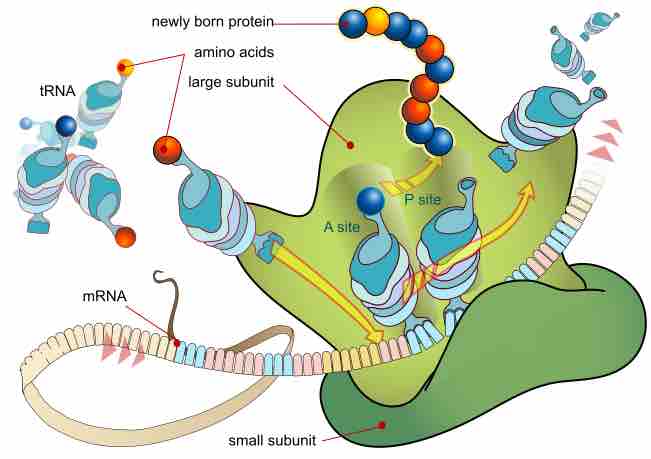A protein synthesis inhibitor is a substance that stops or slows the growth or proliferation of cells by disrupting the processes that lead directly to the generation of new proteins. It usually refers to substances, such as antimicrobial drugs, that act at the ribosome level. The substances take advantage of the major differences between prokaryotic and eukaryotic ribosome structures which differ in their size, sequence, structure, and the ratio of protein to RNA. The differences in structure allow some antibiotics to kill bacteria by inhibiting their ribosomes, while leaving human ribosomes unaffected.
Translation in prokaryotes involves the assembly of the components of the translation system which are: the two ribosomal subunits (the large 50S & small 30S subunits), the mRNA to be translated, the first aminoacyl tRNA, GTP (as a source of energy), and three initiation factors that help the assembly of the initiation complex . The ribosome has three sites: the A site, the P site, and the E site (not shown in ). The A site is the point of entry for the aminoacyl tRNA. The P site is where the peptidyl tRNA is formed in the ribosome. The E site which is the exit site of the now uncharged tRNA after it gives its amino acid to the growing peptide chain.

Simplified diagram of protein synthesis
Diagram showing how the translation of the mRNA and the synthesis of proteins is made by ribosomes.
In general, protein synthesis inhibitors work at different stages of prokaryotic mRNA translation into proteins like initiation, elongation (including aminoacyl tRNA entry, proofreading, peptidyl transfer, and ribosomal translocation), and termination. The following is a list of common antibacterial drugs and the stages which they target.
- Linezolid acts at the initiation stage, probably by preventing the formation of the initiation complex, although the mechanism is not fully understood.
- Tetracyclines and Tigecycline (a glycylcycline related to tetracyclines) block the A site on the ribosome, preventing the binding of aminoacyl tRNAs.
- Aminoglycosides, among other potential mechanisms of action, interfere with the proofreading process, causing an increased rate of error in synthesis with premature termination.
- Chloramphenicol blocks the peptidyl transfer step of elongation on the 50S ribosomal subunit in both bacteria and mitochondria.
- Macrolides, clindamycin, and aminoglycosides have evidence of inhibition of ribosomal translocation.
- Streptogramins also cause premature release of the peptide chain.
By targeting different stages of the mRNA translation, antimicrobial drugs can be changed if resistance develops to one or many of the drugs.